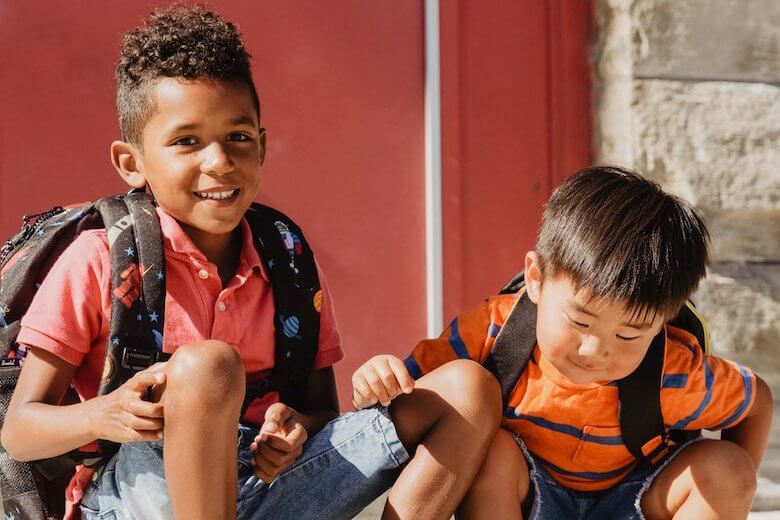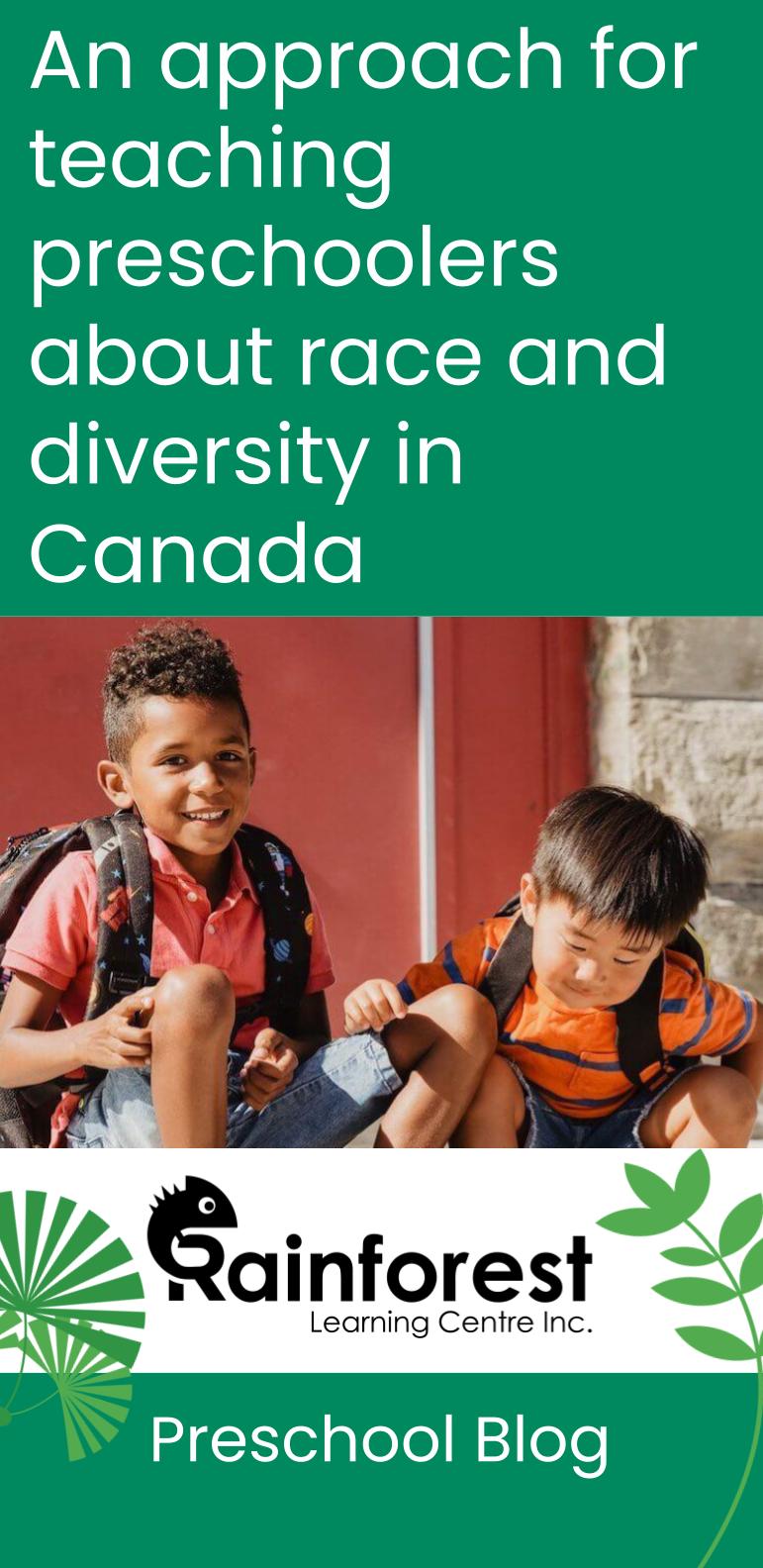
As we’ve all seen, talking about race bias is becoming a big topic in the media. Canada is not immune. People are realizing that this issue is ‘systemic,’ meaning, it’s ingrained in our society – we don’t even realize it’s there unless we’re on the receiving side of it. But wouldn’t it be wonderful if we lived in a society that treated everyone equally, based on merit, and not based on skin colour, ethnicity or any other factor? That’s why we encourage teaching preschoolers about race and diversity – whether in the early childhood classroom or at home.
From our observation, we would say that parents, for the most part, want to do their part. They don’t want to raise racist kids. Yet somehow, name calling, bullying and exclusions can happen among groups of young children, based on visual differences. When parents get reports about it from teachers, it’s shocking! “MY kid said THAT?! Where did they learn it from?!”
And other times, the acts of bias are totally unbeknownst to us. Even we adults don’t know we’re doing it (or we think this is an American problem, not a Canadian one). And children… oh children, they say the wildest things out of curiosity, sometimes.
But to be truthful, this topic can feel complicated. The ‘real’ answer takes an understanding of biology, history, social constructs and more. That can be a lot for a 3 or 4 year old to handle. We don’t have to get into all that with them. There are ways to simplify discussions about race. And, in indirect ways, we can instill ‘anti racism’ into our little ones at an early age.
So in this article, we’ll give some tips on how to address diversity awareness and appreciation at preschool or at home. But before we do, we will say this: we’re White daycare owners. We fully acknowledge that we haven’t had the breadth of experience that those of colour have had. We welcome your ideas and dialogue!
While this article is written from a Canadian perspective, its principles can apply worldwide.
Don’t stifle a child’s curiosity about racial differences, in order to remain ‘polite’
We have a problem among us adults, where we really don’t want to be rude or offensive. So, when our children say something awkward in public, we quickly ‘hush’ them, for fear of embarrassment.
Imagine being in a line up at a grocery store, or in an elevator with a person of another race. Your 4 year old pipes up, points their finger and says, “Why do they have brown hands????” or, “Why are they wearing that?” or, “Look at their hair!”
At this point, it’s important not to react as if the child has committed a crime. They are genuinely curious.
Yes, someone may be offended. You can’t control that. But if that ‘different’ person is open, they may be receptive to you responding with something like:
“Yes! They have dark skin! Isn’t it beautiful? And you have white skin, it’s also nice, right?”
You can normalize differences by reacting this way, instead of suppressing a child’s curiosity. It may invite them to ask more questions, which you can turn into a teachable moment.
Don’t skirt the issue: be direct about racial differences, even if your preschool classroom is homogenous
In the preschool classroom, the above scenario can happen among children. An early childhood educator needs to referee. This can happen; children are aware of racial differences at a young age. They can even prefer a race, believe it or not. They are learning to classify all things, so it’s natural to want to classify people, too.
Children pointing out other childrens’ differences can result in hurt feelings that are hard to cope with. So, just like in the previous example, an adult in this situation may be able to bring two little learners together, by talking about their differences. They can encourage them to notice these things, alongside their similarities.
The goal is to create an environment of open, free dialogue about race. And while doing so, they can ‘spin’ things positively as much as possible (because it is positive!). They can say something age-appropriate like, “isn’t it wonderful that we’re so different and we can all be friends?!”
Finally, during your preschool circle time, be open about race and diversity, as it comes up. Even if your classroom is full of one, or a few races, introduce the children to more ‘options’ and ‘flavours,’ so-to-speak. Show them videos of children in other countries. Have a mini ‘exchange’ day with another classroom that is predominantly of another race. Hang up photos of multicultural children, include multi-race character books and toys, skin colour paints of different shades, and so on.
Below is a great resource for finding books and activities to deal with race, age-by-age:
https://bouncebackparenting.com/resources-for-talking-to-kids-about-race-and-racism/
And here are lesson plans on anti-racism, by the BC Teachers’ Federation (BCTF):
https://bctf.ca/socialjustice.aspx?id=21346
Don’t think that race is a non-issue if your classroom is not diverse. Even if children aren’t asking questions about each other’s differences, you can still bring it up, and address it head on.
Be sensitive to the ethnicities, cultures and races in your classroom and in your community
In the news and in the USA, a major race issue is with African-American communities. However, in Canada, we have many other races and cultures that are predominant minorities in our communities. Of course, around the world, there are people of many races living together. But we can bluntly say that, at least in the Vancouver area, the discussion of racism mostly comes up with regards to First Nations and immigrant, Asian ethnicities. And that’s a large group!
“Asian” includes Chinese, Philipino, Korean, Japanese, Indian, Middle Eastern and more. And within each of those so-called, ‘categories,’ there are differences within them. For example, Indians can be divided by faiths, such as Hindu, Sikh, Muslim, Budhist, Christian and more.
Plus, we are a wonderfully multicultural country! Your classroom may have Latinx, Europeans, Africans and other ‘non-Asian’ peoples, of course.
So in these cases, a discussion or story book that is always about being Black versus being White, may not help as much as including many varieties of races. They are good to include, for sure. But you’ll want your race discussions to be applicable and practical to your classroom.
This may mean that you’ll celebrate Chinese New Year, Vaisakhi, Hanukkah and other cultural traditions that fall within your group of children.
It may also mean teaching children how to say “hello” in all of these languages. Or bringing in traditional costumes and foods from all the ethnicities represented in your classroom.
And, of course, during circle-time discussions, you can address the races of those who are present. If it’s happening, talk about how feelings can be hurt when we say certain mean things about people in our midst. For example, a Chinese immigrant may say “tree” instead of “three.” It’s not nice to make fun of them. We should include them in our play. If we can’t understand them, we can try our very best to communicate with hand signals and gestures.
Talk about what you all have in common too! For example, maybe the children like the same toys. Tell them, “it’s fun to play together, because we’re so much alike on the inside, too!” And then, you can crack open a brown egg and a white egg, and show the classroom that the content inside each is the same – just like us!
Be sure to let them ask questions and share their experiences too. Find out what they think.
To conclude: racism elimination can start early, with simple diversity lessons
As we’ve seen above, children can begin identifying and preferring race at an early age. They do this as they learn to classify things with simplicity, which is ok for their age. However, we can intervene at this early stage by explaining that these very simple differences among us are perfectly ok; they are even wonderful aspects to know about people. Everyone is special.
The depth of detail you go into with a preschool child about race doesn’t have to be complex; they are still learning to absorb the world around them. They may not be able to comprehend the concept of ‘the past’, the ‘West,’ or anything beyond their current reality, which is contained in a very small world; home, family, playground and daycare is pretty much what they know (right?).
Sure, young children may understand ‘yesterday,’ and may be able to spot countries on a map. But they haven’t yet lived through these life dimensions, to truly understand them. So, be simple, be encouraging and start the dialogue early, in an age-appropriate way. Find teachable moments that you can build upon as they grow older. Eventually, they’ll learn more about this multifaceted world we live in. And that’s when you can get into biology, racial history, social justice, and more.
See more on our blog:
- What are age-appropriate manners for preschoolers in early childhood?
- 3 key strategies to teach manners to toddlers and preschool-aged children
- How to handle a preschool bully as a parent or early childhood educator
- What is social competence in the early years?
- 3 ways early childhood educators can help kids get along and feel included
